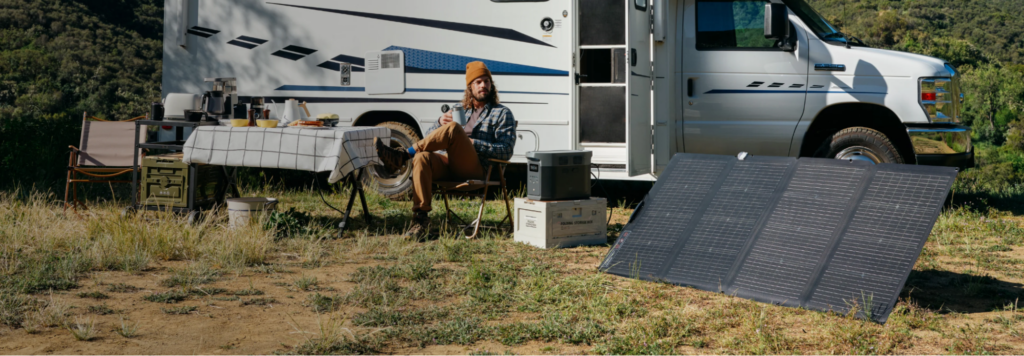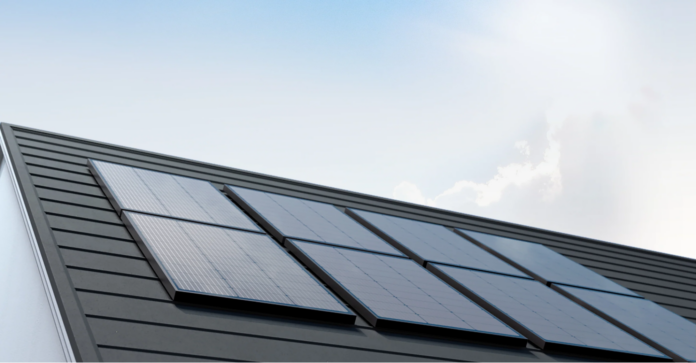Table of Contents
Solar roof tiles are becoming a popular way to harness the sun’s energy to power your home. Though installed similarly to traditional panels, this new kind of roof tiles act as both roof shingles and solar-energy-generating panels – but are they all they’re hyped up to be?
Below, learn how solar roof tiles work and their advantages and disadvantages. Then, compare this option to traditional sun-capturing panels and see how they compare.
What Are Solar Roof Tiles?
Solar roof tiles, also called solar shingles, are a cutting-edge technology that integrates energy collection into your home’s roofing structure. Unlike conventional roof-mounted panels, solar roof tiles blend seamlessly with your existing roof materials, creating a sleek and modern appearance while allowing your roof to work overtime by capturing energy from the sun and turning it into usable power for your home.
These tiles are designed to perform two functions simultaneously. First, they act as a durable roofing material, protecting your home from the elements. Second, they capture the sun’s energy and convert it into electricity, which can be used to power your home or, with a battery storage system, kept safely for later use.
Solar roof tiles come in various styles and colours, making matching them with your home’s aesthetic easy. Homeowners with both traditional and contemporary looks can likely find a style that blends into their current design.

How Do Solar Roof Tiles Work?
Since they’re installed in the same place traditional panels would go, you could assume that solar roof tiles work the same way as these panels. This is true in the sense that the tiles act as panels, which then connect to an inverter and a battery system to create a full generator like EcoFlow Solar Generators.
Learn more about the essential components of any solar roof tile system and discover how they work together to provide clean, renewable energy.
The three vital components any solar setup (including roof tiles) require include:
- Roof Tiles or Panels – These tiles contain photovoltaic (PV) cells made of highly efficient materials like silicon, which capture sunlight as direct current (DC) energy.
- Solar Inverter – Once the roof tiles generate DC energy, it must be inverted into usable alternating current (AC) energy, which household appliances use. An inverter carries out this conversion to ensure all energy generated is usable.
- Battery Storage – A battery storage system is essential for anyone who wants to maximise the use of a solar energy system. Battery storage allows you to hold onto excess energy that your tiles capture during the day, which can then be used at night or on cloudy days. Thus, you always have a supply of energy and can reduce reliance on the electricity grid.
These tiles employ either monocrystalline, polycrystalline, or thin-film panel technology. Monocrystalline versions are the most efficient and expensive, while polycrystalline panels save you money but reduce efficiency. Thin-film panels are another inexpensive option.
Most reliable manufacturers rely on monocrystalline technology because it provides the best performance. While roof tiles look very visually different from panels, they work very much the same.
Solar Roof Tile Installation and Maintenance
If you already have a shingled roof, the shingles must be removed first. If the underlayment is damaged, it may also need to be replaced. For Tesla’s solar roof tiles, they provide a crew of in-house energy professionals that have installed nearly 4 GW of solar across more than 480,000 roofs. They know how to install and ensure the new system works properly.
It may take several days, and you’ll need to go through Tesla to find a crew that can install them. You won’t be able to ask any roofing company to install these very specific and highly specialised roof tiles.
Once installed, you must regularly clean and maintain your new tiles to protect your investment and ensure they continue to produce electricity for your home. You can ask your service provider to conduct maintenance every few years so your tiles continue performing throughout their lifespan.
What Are the Advantages of Solar Roof Tiles?
Solar roof tiles have several notable advantages, making them an attractive option for eco-conscious homeowners. They blend into the natural roof line, making them a more aesthetically pleasing option while saving space that bulky panels would otherwise require.
They can also increase property value and may become more affordable through programs such as government renewable energy tax incentives.
- Aesthetic Appeal: Solar roof tiles blend seamlessly with your existing roof, maintaining your home’s aesthetic while generating renewable energy.
- Space Efficiency: Unlike bulkier standard panels, sun-capturing tiles maximise the use of your roof space without compromising functionality. They can also be used in hard-to-reach places where solar panels may not be possible due to the positioning or design of your roof.
- Limited Damage: These high-tech tiles are part of the roofing, so there’s no need to drill holes or mount heavy, bulky equipment to your current roof.
- Durability: These tiles are built to withstand harsh weather conditions and offer the same protection as traditional roofing materials.
- Energy Savings: Generating electricity can significantly reduce your electricity bills and reduce your reliance on fossil fuels.
- Protection Against the Elements: There’s no additional equipment that may put extra stress on a roof during storms and strong winds.
- Increased Property Value: Homes equipped with solar technology often increase in value, appealing to future eco-conscious buyers.
- Tax Incentives: Tax credits and incentives for installing renewable energy technology may be available, helping offset initial installation costs.
The Disadvantages of Solar Roof Tiles
While these new, sleek tiles offer many benefits, they also have some disadvantages, such as a higher initial cost than adding a few panels, a complex installation that may require the removal of your previous shingles, and limited efficiency rates compared to solar panels.
- Higher Initial Cost: These specialty tiles are more expensive upfront than traditional panels. However, the aesthetic and space-saving benefits can outweigh the initial investment.
- Complex Installation: Installing these roof tiles is more complicated and time-consuming than mounting panels. Regular roof shingles will need to be removed and replaced with solar versions, requiring a roofing team of experts who are experienced in installing this type of renewable energy system. The long-term benefits and seamless integration still make it worth the effort for many homeowners.
- Limited Efficiency: This option will generally have lower efficiency rates than conventional panels. However, as technology advances, their efficiency will steadily improve.
Solar Roof Tiles vs. Solar Panels
If you’re deciding between tiles and panels for your home, comparing specifications such as output and efficiency rating is helpful to see which option provides more value. It’s also a good idea to consider the time it takes to generate a return on the investment (also known as the solar payback period), the speed at which both options can be installed, and how long they last.
Traditional EcoFlow Solar Panels, such as the EcoFlow Rigid Solar Panels and EcoFlow Portable Solar Panels, are highly efficient and have robust outputs, depending on your electricity needs. For example, the EcoFlow 400W Rigid Solar Panel provides a whopping 400W energy output. These panels are also relatively easy and quick to install and last decades.
Here’s a direct comparison between the two popular options of tiles and panels
| Feature | Solar Roof Tiles | EcoFlow Solar Panels |
| Average Output | 165 watts per square foot | 60-400 watts per panel, depending on model |
| Average Efficiency Rating | 10-20% | 20-23% |
| Cost per Watt | Higher ($3-$8) | Lower ($3-$4) |
| Installation Fee | $15k-$48k for Tesla brand | Lower, simpler installation |
| Time to ROI (Solar Payback Period) | 20+ years | 5-15 years |
| Installation Speed | Slower, 5-14 days | Faster, 1-2 days |
| Lifespan | 25-30 years | 25-30 years |

Final Thoughts
Solar roof tiles offer a stylish and innovative way to generate renewable energy while maintaining your home’s aesthetic appeal. Though they come with higher initial costs and complex installation processes, their long-term benefits make them a worthy investment for some eco-conscious homeowners.
If you’re intrigued by this kind of renewable energy technology’s potential and want to explore more options, consider EcoFlow’s Solar Panels. They provide an excellent alternative to solar roof tiles with higher efficiency rates and a faster return on investment.


